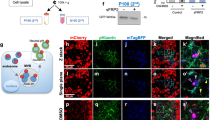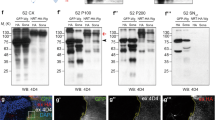Abstract
How functional WNT proteins are made and how their secretion is regulated is becoming a focal point for the WNT-signalling field. Recently, lipoprotein particles, WNT lipid modifications, the conserved transmembrane protein Wntless (WLS; also known as EVI and SRT) and the retromer complex have been implicated in WNT secretion. Our aim is to synthesize ideas from these new findings for the mechanisms that underlie WNT secretion.
This is a preview of subscription content, access via your institution
Access options
Subscribe to this journal
Receive 12 print issues and online access
$189.00 per year
only $15.75 per issue
Buy this article
- Purchase on Springer Link
- Instant access to full article PDF
Prices may be subject to local taxes which are calculated during checkout



Similar content being viewed by others
References
Logan, C. Y. & Nusse, R. The Wnt signaling pathway in development and disease. Annu. Rev. Cell Dev. Biol. 20, 781–810 (2004).
Veeman, M. T., Axelrod, J. D. & Moon, R. T. A second canon. Functions and mechanisms of β-catenin-independent Wnt signaling. Dev. Cell 5, 367–377 (2003).
Clevers, H. Wnt/β-catenin signaling in development and disease. Cell 127, 469–480 (2006).
Kusserow, A. et al. Unexpected complexity of the Wnt gene family in a sea anemone. Nature 433, 156–160 (2005).
Nusse, R. & Varmus, H. E. Many tumors induced by the mouse mammary tumor virus contain a provirus integrated in the same region of the host genome. Cell 31, 99–109 (1982).
Cabrera, C. V., Alonso, M. C., Johnston, P., Phillips, R. G. & Lawrence, P. A. Phenocopies induced with antisense RNA identify the wingless gene. Cell 50, 659–663 (1987).
Rijsewijk, F. et al. The Drosophila homolog of the mouse mammary oncogene int-1 is identical to the segment polarity gene wingless. Cell 50, 649–657 (1987).
Lawrence, P. A. Morphogens: how big is the big picture? Nature Cell Biol. 3, E151–E154 (2001).
Neumann, C. J. & Cohen, S. M. Long-range action of Wingless organizes the dorsal-ventral axis of the Drosophila wing. Development 124, 871–880 (1997).
Zecca, M., Basler, K. & Struhl, G. Direct and long-range action of a Wingless morphogen gradient. Cell 87, 833–844 (1996).
Kiecker, C. & Niehrs, C. A morphogen gradient of Wnt/β-catenin signalling regulates anteroposterior neural patterning in Xenopus. Development 128, 4189–4201 (2001).
Sancho, E., Batlle, E. & Clevers, H. Signaling pathways in intestinal development and cancer. Annu. Rev. Cell Dev. Biol. 20, 695–723 (2004).
Panakova, D., Sprong, H., Marois, E., Thiele, C. & Eaton, S. Lipoprotein particles are required for Hedgehog and Wingless signalling. Nature 435, 58–65 (2005).
Coudreuse, D. Y., Roel, G., Betist, M. C., Destree, O. & Korswagen, H. C. Wnt gradient formation requires retromer function in Wnt-producing cells. Science 312, 921–924 (2006).
Prasad, B. C. & Clark, S. G. Wnt signaling establishes anteroposterior neuronal polarity and requires retromer in C. elegans. Development 133, 1757–1766 (2006).
Banziger, C. et al. Wntless, a conserved membrane protein dedicated to the secretion of Wnt proteins from signaling cells. Cell 125, 509–522 (2006).
Bartscherer, K., Pelte, N., Ingelfinger, D. & Boutros, M. Secretion of Wnt ligands requires Evi, a conserved transmembrane protein. Cell 125, 523–533 (2006).
Goodman, R. M. et al. Sprinter: a novel transmembrane protein required for Wg secretion and signaling. Development 133, 4901–4911 (2006).
Miller, J. R. The Wnts. Genome Biol. 3, reviews3001.1–reviews3001.15 (2002).
Tanaka, K., Kitagawa, Y. & Kadowaki, T. Drosophila segment polarity gene product porcupine stimulates the posttranslational N-glycosylation of Wingless in the endoplasmic reticulum. J. Biol. Chem. 277, 12816–12823 (2002).
Vincent, J. P. & Dubois, L. Morphogen transport along epithelia, an integrated trafficking problem. Dev. Cell 3, 615–623 (2002).
Eaton, S. Release and trafficking of lipid-linked morphogens. Curr. Opin. Genet. Dev. 16, 17–22 (2006).
Willert, K. et al. Wnt proteins are lipid-modified and can act as stem cell growth factors. Nature 423, 448–452 (2003).
Zhai, L., Chaturvedi, D. & Cumberledge, S. Drosophila Wnt-1 undergoes a hydrophobic modification and is targeted to lipid rafts, a process that requires Porcupine. J. Biol. Chem. 279, 33220–33227 (2004).
Takada, R. et al. Mono-unsaturated fatty acid modification of Wnt protein: its role in Wnt secretion. Dev. Cell 11, 791–801 (2006).
Hofmann, K. A superfamily of membrane-bound O-acyltransferases with implications for Wnt signaling. Trends Biochem. Sci. 25, 111–112 (2000).
Kadowaki, T., Wilder, E., Klingensmith, J., Zachary, K. & Perrimon, N. The segment polarity gene porcupine encodes a putative multitransmembrane protein involved in Wingless processing. Genes Dev. 10, 3116–3128 (1996).
Caricasole, A., Ferraro, T., Rimland, J. M. & Terstappen, G. C. Molecular cloning and initial characterization of the MG61 / PORC gene, the human homologue of the Drosophila segment polarity gene Porcupine. Gene 288, 147–157 (2002).
Thorpe, C. J., Schlesinger, A., Carter, J. C. & Bowerman, B. Wnt signaling polarizes an early C. elegans blastomere to distinguish endoderm from mesoderm. Cell 90, 695–705 (1997).
Tanaka, K., Okabayashi, K., Asashima, M., Perrimon, N. & Kadowaki, T. The evolutionarily conserved porcupine gene family is involved in the processing of the Wnt family. Eur. J. Biochem. 267, 4300–4311 (2000).
van den Heuvel, M., Harryman-Samos, C., Klingensmith, J., Perrimon, N. & Nusse, R. Mutations in the segment polarity genes wingless and porcupine impair secretion of the wingless protein. EMBO J. 12, 5293–5302 (1993).
van den Heuvel, M., Nusse, R., Johnston, P. & Lawrence, P. A. Distribution of the wingless gene product in Drosophila embryos: a protein involved in cell–cell communication. Cell 59, 739–749 (1989).
Marois, E., Mahmoud, A. & Eaton, S. The endocytic pathway and formation of the Wingless morphogen gradient. Development 133, 307–317 (2006).
Strigini, M. & Cohen, S. M. Wingless gradient formation in the Drosophila wing. Curr. Biol. 10, 293–300 (2000).
Pfeiffer, S., Ricardo, S., Manneville, J. B., Alexandre, C. & Vincent, J. P. Producing cells retain and recycle Wingless in Drosophila embryos. Curr. Biol. 12, 957–962 (2002).
Futter, C. E., Connolly, C. N., Cutler, D. F. & Hopkins, C. R. Newly synthesized transferrin receptors can be detected in the endosome before they appear on the cell surface. J. Biol. Chem. 270, 10999–11003 (1995).
Ang, A. L. et al. Recycling endosomes can serve as intermediates during transport from the Golgi to the plasma membrane of MDCK cells. J. Cell. Biol. 167, 531–543 (2004).
Pfeffer, S. R. Membrane transport: retromer to the rescue. Curr. Biol. 11, R109–R111 (2001).
Seaman, M. N. Recycle your receptors with retromer. Trends Cell Biol. 15, 68–75 (2005).
Arighi, C. N., Hartnell, L. M., Aguilar, R. C., Haft, C. R. & Bonifacino, J. S. Role of the mammalian retromer in sorting of the cation-independent mannose 6-phosphate receptor. J. Cell Biol. 165, 123–133 (2004).
Verges, M. et al. The mammalian retromer regulates transcytosis of the polymeric immunoglobulin receptor. Nature Cell Biol. 6, 763–769 (2004).
Gleeson, P. A., Lock, J. G., Luke, M. R. & Stow, J. L. Domains of the TGN: coats, tethers and G proteins. Traffic 5, 315–326 (2004).
Wistrand, M., Kall, L. & Sonnhammer, E. L. A general model of G protein-coupled receptor sequences and its application to detect remote homologs. Protein Sci. 15, 509–521 (2006).
Bard, F. & Malhotra, V. The formation of TGN-to-plasma-membrane transport carriers. Annu. Rev. Cell Dev. Biol. 22, 439–455 (2006).
Burke, R. et al. Dispatched, a novel sterol-sensing domain protein dedicated to the release of cholesterol-modified Hedgehog from signaling cells. Cell 99, 803–815 (1999).
Traub, L. M. Common principles in clathrin-mediated sorting at the Golgi and the plasma membrane. Biochim. Biophys. Acta 1744, 415–437 (2005).
McNiven, M. A. & Thompson, H. M. Vesicle formation at the plasma membrane and trans-Golgi network: the same but different. Science 313, 1591–1594 (2006).
Nusse, R. Wnts and Hedgehogs: lipid-modified proteins and similarities in signaling mechanisms at the cell surface. Development 130, 5297–5305 (2003).
Mann, R. K. & Beachy, P. A. Novel lipid modifications of secreted protein signals. Annu. Rev. Biochem. 73, 891–923 (2004).
Chen, M. H., Li, Y. J., Kawakami, T., Xu, S. M. & Chuang, P. T. Palmitoylation is required for the production of a soluble multimeric Hedgehog protein complex and long-range signaling in vertebrates. Genes Dev. 18, 641–659 (2004).
Bard, F. et al. Functional genomics reveals genes involved in protein secretion and Golgi organization. Nature 439, 604–607 (2006).
Pelkmans, L. Secrets of caveolae- and lipid raft-mediated endocytosis revealed by mammalian viruses. Biochim. Biophys. Acta 1746, 295–304 (2005).
Oving, I. M. & Clevers, H. C. Molecular causes of colon cancer. Eur. J. Clin. Invest. 32, 448–457 (2002).
Hackam, A. S. The Wnt signaling pathway in retinal degenerations. IUBMB Life 57, 381–388 (2005).
Niemann, S. et al. Homozygous WNT3 mutation causes tetra-amelia in a large consanguineous family. Am. J. Hum. Genet. 74, 558–563 (2004).
Hartmann, C. A Wnt canon orchestrating osteoblastogenesis. Trends Cell Biol. 16, 151–158 (2006).
Janssens, N., Janicot, M. & Perera, T. The Wnt-dependent signaling pathways as target in oncology drug discovery. Invest. New Drugs 24, 263–280 (2006).
Wong, G. T., Gavin, B. J. & McMahon, A. P. Differential transformation of mammary epithelial cells by Wnt genes. Mol. Cell. Biol. 14, 6278–6286 (1994).
van Vliet, C., Thomas, E. C., Merino-Trigo, A., Teasdale, R. D. & Gleeson, P. A. Intracellular sorting and transport of proteins. Prog. Biophys. Mol. Biol. 83, 1–45 (2003).
Rodriguez-Boulan, E., Kreitzer, G. & Musch, A. Organization of vesicular trafficking in epithelia. Nature Rev. Mol. Cell Biol. 6, 233–247 (2005).
Author information
Authors and Affiliations
Corresponding author
Ethics declarations
Competing interests
The authors declare no competing financial interests.
Related links
Rights and permissions
About this article
Cite this article
Hausmann, G., Bänziger, C. & Basler, K. Helping Wingless take flight: how WNT proteins are secreted. Nat Rev Mol Cell Biol 8, 331–336 (2007). https://doi.org/10.1038/nrm2141
Published:
Issue Date:
DOI: https://doi.org/10.1038/nrm2141
This article is cited by
-
ACSL5, a prognostic factor in acute myeloid leukemia, modulates the activity of Wnt/β-catenin signaling by palmitoylation modification
Frontiers of Medicine (2023)
-
Integration of transcriptomics and metabolomics reveals amelanism mechanism of Oscar Astronotus ocellatus (Agassiz, 1831)
Hydrobiologia (2023)
-
Knockdown of SERPINB2 enhances the osteogenic differentiation of human bone marrow mesenchymal stem cells via activation of the Wnt/β-catenin signalling pathway
Stem Cell Research & Therapy (2021)
-
The emerging role of substance P/neurokinin-1 receptor signaling pathways in growth and development of tumor cells
Journal of Physiology and Biochemistry (2019)
-
Crosstalk between hepatic tumor cells and macrophages via Wnt/β-catenin signaling promotes M2-like macrophage polarization and reinforces tumor malignant behaviors
Cell Death & Disease (2018)



